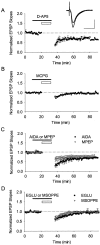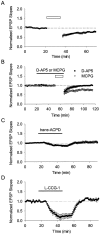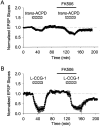Calcineurin plays different roles in group II metabotropic glutamate receptor- and NMDA receptor-dependent long-term depression
- PMID: 12077199
- PMCID: PMC6757754
- DOI: 10.1523/JNEUROSCI.22-12-05034.2002
Calcineurin plays different roles in group II metabotropic glutamate receptor- and NMDA receptor-dependent long-term depression
Abstract
We investigated metabotropic glutamate receptor (mGluR)-dependent long-term depression (LTD) in hippocampal CA1 pyramidal neurons of 6- to 8-d-old [postnatal days 6-8 (P6-P8)] and 21- to 25-d-old (P21-P25) rats. In P6-P8 rats, induction of LTD depended on the activity of group II mGluRs. In P21-P25 rats, however, this LTD disappeared, and instead, NMDA receptor (NMDAR)-dependent LTD appeared. A bath containing a specific calcineurin (CaN) inhibitor restored the group II mGluR-dependent LTD in the neurons of the P21-P25 rats. Although postsynaptic injection of CaN inhibitors suppressed NMDAR-dependent LTD, it did not affect induction of group II mGluR-dependent LTD. These results demonstrate that CaN plays different roles in the induction of two forms of LTD: presynaptic CaN inhibits group II mGluR-dependent LTD, whereas postsynaptic CaN facilitates NMDAR-dependent LTD. These findings are the first demonstration in vitro of group II mGluR-dependent LTD that is negatively regulated by CaN via an age-dependent mechanism.
Figures







References
-
- Anwyl R. Metabotropic glutamate receptors: electrophysiological properties and role in plasticity. Brain Res Brain Res Rev. 1999;29:83–120. - PubMed
-
- Bashir ZI, Jane DE, Sunter DC, Watkins JC, Collingridge GL. Metabotropic glutamate receptors contribute to the induction of long-term depression in the CA1 region of the hippocampus. Eur J Pharmacol. 1993;239:265–266. - PubMed
-
- Bear MF, Malenka RC. Synaptic plasticity: LTP and LTD. Curr Opin Neurobiol. 1994;4:389–399. - PubMed
MeSH terms
Substances
LinkOut - more resources
Full Text Sources
Research Materials
Miscellaneous
